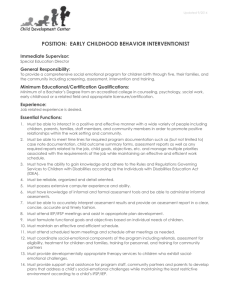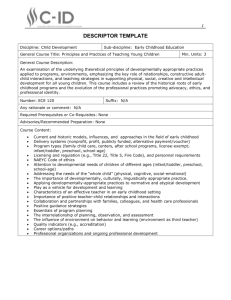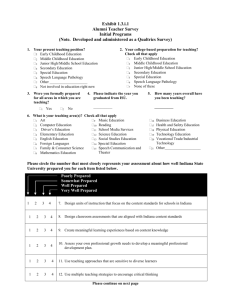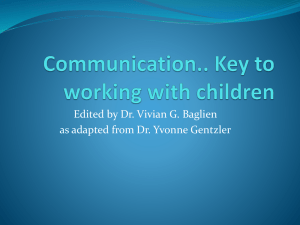Standardized Guidance
advertisement
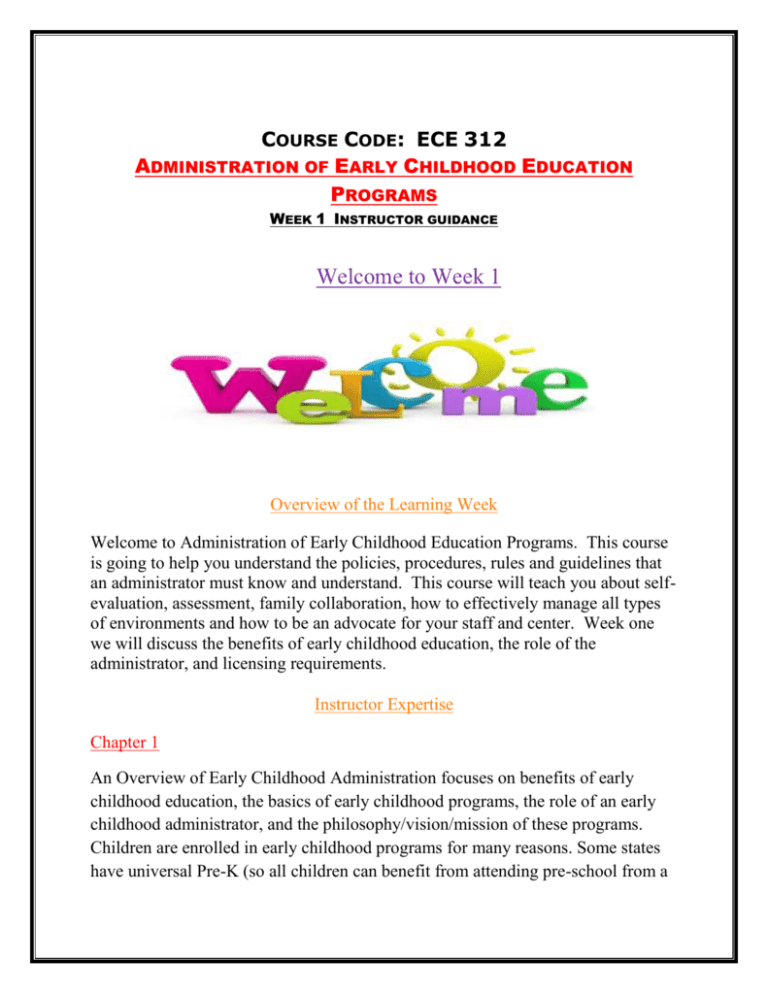
COURSE CODE: ECE 312 ADMINISTRATION OF EARLY CHILDHOOD EDUCATION PROGRAMS WEEK 1 INSTRUCTOR GUIDANCE Welcome to Week 1 Overview of the Learning Week Welcome to Administration of Early Childhood Education Programs. This course is going to help you understand the policies, procedures, rules and guidelines that an administrator must know and understand. This course will teach you about selfevaluation, assessment, family collaboration, how to effectively manage all types of environments and how to be an advocate for your staff and center. Week one we will discuss the benefits of early childhood education, the role of the administrator, and licensing requirements. Instructor Expertise Chapter 1 An Overview of Early Childhood Administration focuses on benefits of early childhood education, the basics of early childhood programs, the role of an early childhood administrator, and the philosophy/vision/mission of these programs. Children are enrolled in early childhood programs for many reasons. Some states have universal Pre-K (so all children can benefit from attending pre-school from a public school with a licensed early childhood educator). Many families may need childcare, some children could benefit from socialization, and/or they are considered at risk and could use extra early education. High-quality childcare programs are essential for children, as the first five years of a child’s life are the most crucial years; they are learning and retaining all new information. There is also an economic benefit from high-quality childcare programs; these children grow up to participate in the workforce and better the economy (Gadzikowski, 2013). Everyone benefits from high-quality childcare. Luckily, there are a variety of programs for families to choose from including, state agencies, federal agencies, college/university- run programs, and private facilities (Gadzikowski, 2013). It’s quite a decision for parents when they have to choose a childcare program. Parents should make it a top priority to ask questions, tour the facility, and understand the rules, policies, and procedures of the center. Another important part of high-quality childcare is the administrator; these people can have different titles as well as different roles depending on the type of program they are supervising. Administrators take on responsibilities that include center directors, curriculum coordinators, teacher supervisors, and program managers; given the long list of responsibilities, administrators need to be courageous, confident, assertive, resourceful, and flexible (Gadzikowski, 2013). Whether you are a parent or teacher, the program’s philosophy (school of thought or theory) is something to consider; the philosophy is important in deciding whether the program is a good fit. Let’s not forget the program’s vision and mission. The vision statement is a general statement of what the program hopes to accomplish while the mission statement describes why the program exists, what it does, and who it serves (Gadzikowski, 2013). The philosophy, vision, and mission are all important parts to consider when looking into childcare. About Head Start This article on Head Start gives you information about the background, history, and theory of what Head Start is, and why it is important. Universal Pre-K This article gives useful information on Pre-K. Chapter 2 Ensuring Program Quality, focuses on the director’s role in the licensing and administration process. Childcare programs need to adhere to the regulations and rules of operation, and the administrators need to ensure that the standards are followed. Minimum standards must be met, while voluntary standards usually indicate high-quality care. In addition to these standards is accreditation (a supplement to the license). Accreditation is not only a status but also a process that includes the following steps: enrollment, completion of the self-study, compilation of materials, and confirmation of quality (Gadzikowski, 2013). All childcare facilities must obtain a license to operate; licenses may vary slightly depending on the type of program, but they all have the same basic components. Common categories for licensing include organization and administration, staffing, facility and equipment, nutrition and food service, and health and safety (Gadzikowski, 2013). Licensing can also vary from state to state. Childcare facilities must also adhere to building and health codes. A somewhat new development is the quality rating and improvement systems (QRIS), used to assess, improve, and communicate the level of quality in childcare programs and early education (Gadzikowski, 2013). This all sounds quite overwhelming for an administrator so be sure to understand the different roles involved in supervising a childcare program before you accept the challenge! Critical Reflections/Application Opportunities Do you feel like you have the background to go through an accreditation process? Do you feel like you would be ready to write a centers mission, philosophy, and beliefs? What are the first steps you should take? * How many different titles and roles can you think of that an administrator of a building may have to step up and do? What do you believe is the primary role of the early childhood administrator? Additional Resources The History of Early Childhood Education The Impact Of Quality Administration and Leadership Effective Leadership abilities for Early Childhood Professionals Program Administrators and their Voices Weekly Learning Activities What’s due… Discussion: Introduction grade Day 1 2% of Discussion: Philosophy, Mission, and Vision grade Day 3 (1st post) 4% of Discussion: Accreditation grade Day 3 (1st post) 4% of Journal: Week 1 grade Day 7 2% of * Remember to always look at the grading rubric and use correct APA format on all assignments! I recommend that you continuously refer back to the rubric while writing your discussion posts and journal assignment; this will help you receive the maximum amount of points for each required section. Required Text 1. Administration of Early Childhood Education Programs: a. Chapter 1: An Overview of Early Childhood Administration This first chapter serves as an overview of the role of an early childhood administrator and an introduction to the broad variety of program types and structures. b. Chapter 2: Ensuring Program Quality In this chapter, you will learn about the standards that are used to regulate early childhood programs and the regulation process. This chapter also focuses on the director’s role in the licensing and accreditation processes. Article 1. National Association for the Education of Young Children. (2008). Overview of the NAEYC early childhood program standards. Retrieved from http://www.naeyc.org/files/academy/file/OverviewStandards.pdf summarizes the NAEYC’s accreditation standards for quality early childhood programs. Websites 1. Sunshine and Stars Child Care, LLC. (2005). Mission, philosophy, vision, values. Retrieved from http://www.sunshineandstarschildcare.com/missio evaluate the philosophy, mission, and vision of the Sunshine and Stars Child Care center. 2. Queen Emma Preschool. (n.d.). Mission, vision and philosophy. Retrieved from te the philosophy, mission, and vision of the Queen Emma Preschool. Recommended Resources Article 1. Elkind, D. (2010). History of early childhood education: Chapter one from TheWisdom of Play. Retrieved from http://www.communityplaythings.com/resources/articles/2010/history-ofearly-childhood-education Multimedia 1. Children’s Defense Fund. (2013). Children in the states factsheets 2013 [Interactive map]. Retrieved from http://www.childrensdefense.org/child-research-datapublications/data/state-data-repository/children-in- the-states.html 2. This interactive map shows important statistics for each state related to children’s well-being. National Resource Center for Health and Safety in Child Care and Early Education. (n.d.). State licensing and regulation infor mation. Retrieved from http://nrckids.org/STATES/states.htm The National Resource Center for Health and Safety in Child Care and Early Education is a nonprofit organization that provides resources to parents, providers, and policy-makers. This web page contains links to access child care regulations from all fifty states. Websites 1. 2. Glogster (http://www.glogster.com/) Create an interactive poster with text, graphics, video, audio, and more. Jing (http://www.techsmith.com/jing.html) 3. Use Jing for screenshots or screen captures. National Association for the Education of Young Children. (n.d.). Critical facts about programs for young children. Retrieved from http://www.naeyc.org/policy/advocacy/ProgramFacts This NAEYC link answers many questions about child care in the U.S. 4. National Resource Center for Health and Safety in Child Care and Early Education. (n.d.). State licensing and regulation infor mation. Retrieved from http://nrckids.org/STATES/states.htm The National Resource Center for Health and Safety in Child Care and Early Education is a nonprofit organization that provides resources to parents, providers, and policy-makers. This web page contains links to access child care regulations from all fifty states. 5. Storybird (http://storybird.com/) 6. Tagxedo (http://www.tagxedo.com/app.html) 7. Share your introduction with your own book created in Storybird. Tagxedo lets you create an interactive tag cloud in a variety of shapes. United States Department of Health & Human Services. (n.d.). Office of Head Start: About. Retrieved from http://www.acf.hhs.gov/programs/ohs/about The government website for the Department of Health and Human Services provides information about Head Start for professionals, families, and the general public. 8. VoiceThread (http://voicethread.com/) 9. Record your voice and add pictures and graphics to introduce yourself. Wordle (http://www.wordle.net/) Make a word cloud of terms that best describe you. Discussions Participated in the following discussions: 1. 1st Post Due by Day 1. Post Your Introduction. Option One: Post a brief introduction on the first day of class. In your introduction, explain why you want to become an early childhood administrator and how you think the course outcomes will help you in your current or future career. Give specific examples of why this profession is important to you, and maybe life experiences that help you form an opinion. Option Two: Post a brief introduction on the first day of class. In your introduction, describe the ways in which the responsibilities of the early childhood administrator differ from those of the early childhood teacher. Give some specific examples. While you are welcome to give a text-based introduction, please feel free to use one of the digital tools below for either option: a. Glogster b. Jing c. Tagxedo d. Storybird e. VoiceThread f. Wordle Guided Response: Respond to at least three of your classmates’ introductions. Use this forum to get acquainted and for ongoing discussions. 2. 1st Post Due by Day 3. Philosophy, Vision, and Mission. According to Gadikowski (2013), “The vision and mission statements of an early childhood program often reflect the organization’s philosophy, that is, its beliefs about how children best learn and develop” (Section 1.4). Imagine you have just been hired as the director of a new child care center. Your first task is to develop the philosophy, vision, and mission for the new center. To assist you with this task, first evaluate the philosophy, vision, and mission statements of the following preschools: a. Sunshine and Stars Child Care b. Queen Emma Preschool Using Table 1.1 “Philosophy, Vision, andMission as Administrative Tools,” and information from Chapter 1 of the textbook, evaluate the schools’ philosophy, vision, and mission statements. Use the terms distinguished, proficient, or approaching to evaluate the statements, and explain why you chose those terms. Next, outline the philosophy, vision, and mission for your new childcare center. Be sure to include what you have learned from the text and from your evaluations to help shape your ideas. Make sure you consider what and how you believe children learn, how you will support your staff and faculty, and what you believe to be important in early childhood development. Your discussion post should be at least 200 words in length. Guided Response: After reviewing several of your classmates’ posts, respond to at least two peers by evaluating the philosophy, vision, and mission statements they created. Be sure to use the terms distinguished, proficient, and approaching and provide reasoning to support your evaluations. Each response should be at least 50 words in length. 3. 1st Post Due by Day 3. Accreditation. Many early childhood education centers are accredited by organizations such as the National Association for the Education of Young Children (NAEYC). Being accredited by such an organization shows that the center provides a high-quality learning experience that exceeds minimal standard licensing requirements. For this discussion, imagine that you are the director of a childcare center and you would like to pursue NAEYC accreditation. You discuss this idea with the owner of the center, who says that accreditation will cost too much money and does not agree to pursue it. Carefully review the article, “Overview of the NAEYC Early Childhood Program Standards,” and write a persuasive letter to the owner in the hopes of changing her mind. Why do you believe accreditation to be important? Who benefits from accreditation? What are some ways to go through accreditation that can be handled on a limited budget? Be sure to use appropriate early childhood terminology as you discuss the benefits of accreditation. Your discussion post should be at least 200 words in length. Guided Response: Review several of your classmates’ posts. Pretend that you are the owner of the center and you have just read the director’s letter. Construct counter arguments to at least two of your peers explaining how the center can still have a high-quality program without seeking accreditation. Each response should be at least 50 words in length. Journal 1. Due by Day 7. Week One Journal. Why is it important to have a dedicated and knowledgeable leader in an early childhood education setting? Describe two to three qualities that you feel are critical for such a leader to possess. Draw either from your own experiences working in the early childhood field or from your own childhood. What do you hope to gain from this course as a future early childhood administrator? References: Colker, L. (n.d). Pre-K (What Exactly Is It?) Retrieved from http://www.naeyc.org/files/tyc/file/PreK-WhatExactlyIsIt.pdf Gadzikowski, A. (2013). Administration of Early Childhood Education Programs. San Diego, CA: Bridgepoint Education. ISBN: 978-1-62178-5705 Office of Head Start, Administration for Children and Families, U.S. Department of Health and Human Services. (2010). The Head Start Child Development and Early Learning Framework: Promoting Positive Outcomes in Early Childhood Programs Serving Children 3–5 Years Old. Retrieved from http://eclkc.ohs.acf.hhs.gov/hslc/ttasystem/teaching/eecd/Assessment/Child %20Outcomes/HS_Revised_Child_Outcomes_Framework%28revSept2011%29.pdf Guidance written by Dr. Tisha Shipley, parts were taken from Kathleen Kelley’s guidance.





